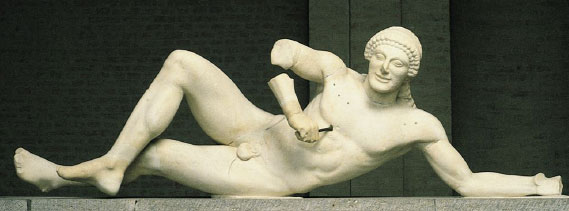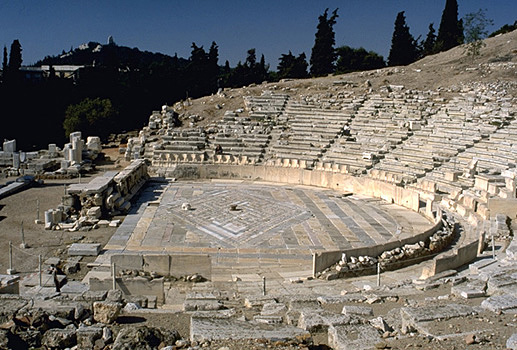There are no surviving masks that were actually worn from Ancient Greek Theater. This is due in part to the fact that they were made from perishable material such as “stiffened linen or wood” (MAE). We do have some remaining terracotta examples, which were not worn, but would have been dedicated to temples. Some of the earliest known images of Gorgons in fact come from terracotta masks from the 7th century from a shrine of Artemis (Napier 1986). These terracotta examples were votive substitutes for the real things (Mack 1994). As for their form, “masks covered more than just the face, being put on over the head like a helmet” (Mack 1994). In fact, in both “The Iliad” and Sophocles’ “Ajax” the helmet acts as a terrifying mask that scares both Hector’s and Ajax’s sons respectively. This form of mask was probably not terribly comfortable. It covered the face, slightly restricting breathing and most likely was a little weighty. It had to be placed carefully so as to allow eyesight for the actor and the actor has to be constantly aware of keeping the mask in check. In one of the Interviews, I discussed this placement with an actor.
One particularly important point I would like to make about Greek Masks, and their representation in Greek Art, is the importance of frontality. The Greek amphitheater is designed as a frontal setting. The actors are meant to perform facing the audience. This implies that the Greek Mask is really only intended to be seen from one direction, in full frontal. In Greek Art, as we saw from our examination of arybolloi, most figures are shown in profile view. When Greek Artists wanted to impart a moment of high drama they “departed from the convention of showing the human head in profile and portrayed it face on” (Mack 1994). Often this would be the moment right before death, as is shown in the pediment from the Temple of Aphaia at Aegina. The dying warrior pulls an arrow out from his chest and looks out at the viewer with his eerie archaic smile. This gives a vast amount of importance to the eyes, which were clearly significant in Greek culture given the myth of the Gorgon Medusa.

One last note on the physicality of the Greek Mask; the lack of profile also lends itself to the context of the theater in which it was performed. Remember, the actors would be performing for 16,000 people and although the Greeks were geniuses of engineering so that the sound would be heard everywhere in the theater, it is hard to believe that every single person in the theater could have seen the actual actor’s features. Thus, the mask serves as to enlarge the features. This also implies that the dramatic actor was less affected by the features of the mask, but rather the mask affected by the actor. The actor’s physicality and voice becomes so much more significant as the mask becomes farther away. Instead of a facial expression, the actor must tilt his head to imply emotion (Prosperi 1992). Tragic masks eventually became exaggerated into what we see in Roman times. This is mainly due to the elaboration of theater buildings, because “the actor was required to appear more conspicuous so as not to be dwarfed by the grandiose setting” so a type of mask with “wide staring eyes and gaping, seemingly screaming mouth belongs to the later Hellenistic and Roman periods. A high forehead added height to the actor’s stature” (Mack 1994). Thus, tragic masks relied less on individual characteristics and more on the “drama and libretto of the actor” (Mack 1994). This differs dramatically from Comedic masks, which experience the phenomena of the mask dictating the actor as opposed to the actor directing the mask, which is probably in part because comedic characters are static while tragic characters transform (see Comedy and Tragedy).

